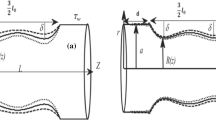Abstract
The effects of gravitational forces and wall thickness on the behaviour of a model of blood flow through axisymmetric vessels were studied. The governing fluid dynamic equations were derived from the Navier-Stokes equations for an incompressible fluid and linked to a simple model of the vessel wall. A closed form of the hyperbolic partial differential equations was found, including a significant source term from the gravitational forces. The inclination of the vessel is modelled using a slope parameter that varied between −1 and 1. The wave speed was shown to be related to the wall thickness, and the time to first shock formation was shown to be directly proportional to this thickness. Two non-dimensional parameters were derived for the ratio of gravitational forces to viscous and momentum forces, respectively, and their values were calculated for the different types of vessel found in the human vasculature, showing that gravitational forces were significant in comparison with either viscous or momentum forces for every type of vessel. The steady-state solution of the governing equations showed that gravitational forces cause an increase in area of approximately 5% per metre per unit slope. Numerical simulations of the flow field in the aorta showed that a positive slope causes a velocity pulse to change in amplitude approximately linearly with distance: −4% per metre and +5% per metre for vessels inclined vertically upwards and downwards, respectively, in comparison with only +0.5% for a horizontal vessel. These simulations also showed that the change relative to the zero slope condition in the maximum rate of change of area with distance, which was taken to be a measure of the rate of shock formation, is proportional to both the slope and the wall thickness-to-inner radius ratio, with a constant of proportionality of 1.2. At a ratio of 0.25, typical of that found in human arteries, the distance to shock formation is thus decreased and increased by 30% for vessels inclined vertically downwards and upwards, respectively. Gravity and wall thickness thus have a significant impact on a number of aspects of the fluid and wall behaviour, despite conventionally being neglected.
Similar content being viewed by others
References
Canic, S., andMikelic, A. (2002): ‘Effective equations describing the flow of a viscous incompressible fluid through a long elastic tube’,Comptes Rendus de l'Academie des Sciences, SerieI, pp. 661–666
Canic, S., andKim, E. H. (2003): ‘Mathematical analysis of the quasilinear effects in a hyperbolic model of blood flow through compliant axi-symmetric vessels’,Math. Meth. Appl. Sci.,26, pp. 1161–1186
Formaggia, L., Nobile, F., Quarteroni, A., andVeneziani, A. (1999): ‘Multiscale modelling of the circulatory system: a preliminary analysis’,Comput. Visual. Sci.,2, pp. 75–83.
Leveque, R. J. (1992): ‘Numerical methods for conservation laws’ (Birkhauser, Boston, 1992)
Leveque, R. J. (2002): ‘Finite volume methods for hyperbolic problems’ (Cambridge University Press, 2002)
Massey, B. S., andWard-Smith, J. (1998): ‘Mechanics of fluids’ (Chapman and Hall, 1998)
Pedrizetti, G. (1998): ‘Fluid flow in a tube with an elastic membrane insertion’,J. Fluid Mech.,375, pp. 36–64
Pontrelli, G. (2002): ‘A mathematical model of flow in a liquid-filled visco-elastic tube’,Med. Biol. Eng. Comput.,40, pp. 550–556
Pontrelli, G., andRossoni, E. (2003): ‘Numerical modelling of the pressure wave propagation in the arterial flow’,Int. J. Num. Methods Fluids,43, pp. 651–671
Quarteroni, A., andVeneziani, A. (2003): ‘Analysis of a geometrical multiscale model based on the coupling of ODEs and PDEs for blood flow simulations’,Multiscale Model. Simul.,1, pp. 173–195
Rideout, V., andDick, D. (1967): ‘Difference-differential equations for fluid flow in distensible tubes’,IEEE Trans. Biomed. Eng.,14, pp. 171–177
Schneck, D. J. (2000): ‘An outline of cardiovascular structure and function’, inBronzino, J. D. (Ed.): ‘The biomedical engineering handbook’ (CRC Press, 2000), pp. 1/1-1/12
Smith, N. P., Pullan, A. J., andHunter, P. J. (2000): ‘The generation of an anatomically accurate geometric coronary model’,Ann. Biomed. Eng.,28, pp. 14–25
Smith, N. P., Pullan, A. J., andHunter, P. J. (2002): ‘An anatomically based model of transient coronary blood flow in the heart’,SIAM J. Appl. Math.,62, pp. 990–1018
Ursino, M., andLodi, C. A. (1998): ‘Interaction among autoregulation, CO2 reactivity, and intracranial pressure: a mathematical model’,Am. J. Physiol.,274, pp. H1715-H1728
Westerhof, N., Bosman, F., Vries, C., andNoordergraf, A. (1969): ‘Analog studies of the human systemic arterial tree’,J. Biomech.,2, pp. 121–143
Author information
Authors and Affiliations
Corresponding author
Rights and permissions
About this article
Cite this article
Payne, S.J. Analysis of the effects of gravity and wall thickness in a model of blood flow through axisymmetric vessels. Med. Biol. Eng. Comput. 42, 799–806 (2004). https://doi.org/10.1007/BF02345213
Received:
Accepted:
Issue Date:
DOI: https://doi.org/10.1007/BF02345213




